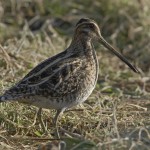Snipe & redwing numbers increasing
Written on November 6 as the weekly Wildlife Sightings column in the Chichester Observer newspaper.
Snipe
During this morning's bird count I spotted 17 snipe on the reserve. We have snipe here all year round but migrants from eastern europe swell the numbers in autumn, building to a high of 30-40 birds between Dec-Feb. These small waders can be found skulking in the vegetation on the waters edge near our Ramsar hide. Their mottled brown backs with buff stripes help them to blend in with the reeds, avoiding predators like the sparrow hawk. Snipe will flush when startled and fly in an unpredictable zig zag pattern to avoid being caught.
Snipe leave the reserve early each evening to feed over the wider Arun Valley in the protective darkness. They return to our reserve later on that night to roost. Snipe use their long straight bill to probe for insects and worms in soft mud. The Arun valley is very wet right, now giving snipe many places to feed, but when the still pools freeze up in winter, they seek out faster flowing waters.
Snipe breed in the UK and in the Arun Valley breeding pairs can be found at Amberley and Pulborough Brooks. Snipe have not bred at WWT Arundel since the 1970's. Numbers have been declining in southeast due to field drainage. In springtime snipe produce a drumming sound during courtship flights. When the birds go into a steep dive, wind rushes through stiff feathers near their tails to produce a drumming sound.
During my closing walk-around I see several redwings tonight. They have been coming in to roost on the reserve in the evenings. During the day these winter visitors feed on hawthorn berries in our hedgerows and on the invertebrates in nearby fields. These small thrush have a cream stripe above their eye and orange-red flank and underwing. Redwings form loose flocks in winter with field fares, black birds and starlings.
Water rail
While strolling the boardwalk I hear three water rail squeal behind me in the reedbed. At the Reedbed hide I watch a water rail pick its way along the edge of the reeds of a pond, its reddish beak making it visible in the greying dusk.
Wildlife sightings: 8 shelduck, 8 lapwing, and increasing numbers of teal. Cormorants and herons fishing on Swan Lake. Little grebes have moved over to Scrape hide and the Tundra pen. Cetti's warbler singing in the carr woodland. Flocks of redpoll on the reserve. Greylag geese and Canadian geese roosting on the wet grassland.


